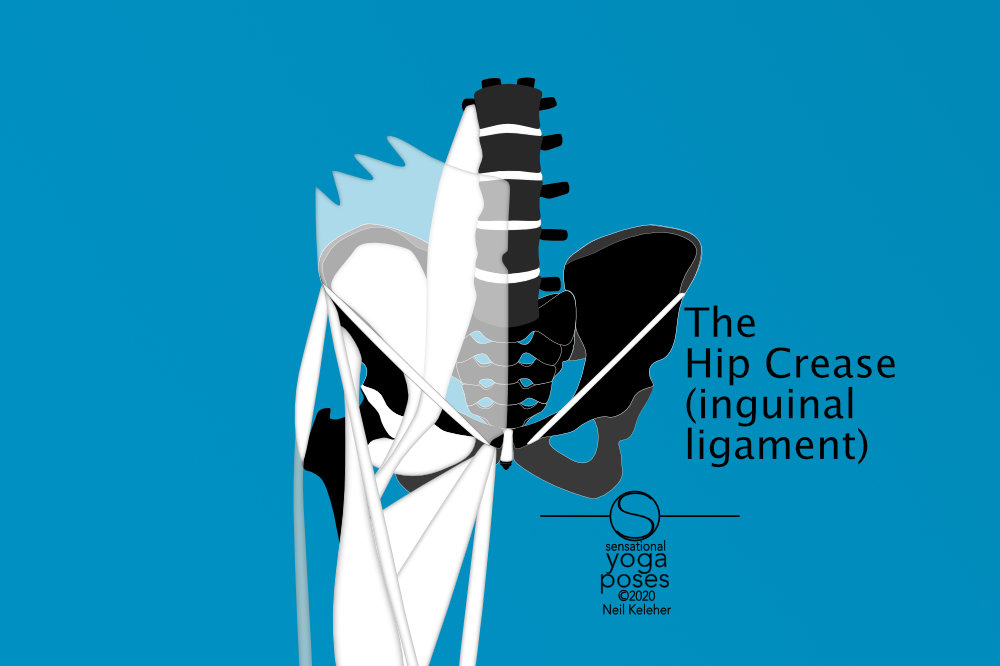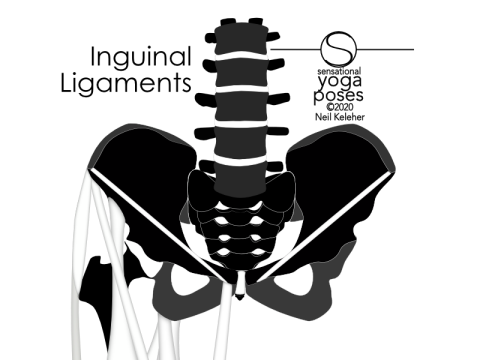The hip crease
A proprioceptive reference for improving hip awareness and hip control
One way to get a better feel for and control of your hip joints (and the muscles that work on them) is via the hip crease.
And actually, when I first started working with this anatomical land mark, I tended to think of it using the Chinese term which is Kua.
Now the Chinese might have meant a lot more than just the hip crease when talking about the kua. I'm going to talk about my own experience with the hip crease.
First of all, what is the hip crease?
What is the hip crease?
The hip crease is the line that separates your belly from your inner thigh. It's actually caused by the inguinal ligament.
This ligament runs between the ASICs (the point of the hip crest, more specifically, the forward or front point of the hip crest) and the pubic bone.
Muscles that can pull on the hip crease
The inguinal ligament is formed by the transverse abdominis and the external obliques. As such it can be pulled on by these muscles.
The transverse abdominis can pull each hip crease inwards, towards the opposite side. And this can have an affect on the SI joint, helping to nutate or nod the sacrum forwards relative to the hip bones, or resist it counter nutating or nodding back.
The external obliques can exert and upwards pull on the inguinal ligament and that may be useful in helping to anchor both the ASIC and pubic bone.
Other muscles that are at or near the hip crease
Muscles that pass under the inguinal ligament include the psoas and the iliacus.
Other muscles that attach close to the inguinal ligament at the ASIC include the sartorius and tensor fascia latae. Meanwhile at the pubic bone you have the gracilis, pectineus, adductor brevis and adductor longus.
Two basic proprioceptive sensations
Now before going on to the hip crease itself it may be helpful to understand two basic sensations that can be used proprioceptively.
One sensation is connective tissue stretch. We get this sensation when connective tissue is stretched beyond a certain point. This can be tendon or ligament stretch. It can also be investing fascia stretch. Investing fascia is the connective tissue within a muscle.
Another sensation is muscle activation sensation. This is the sensation we can feel when muscles activate, particularly larger muscles or muscles with numerous elements.
We can get a taste of both types of sensation when learning to open and close the hip crease.
Basic opening and closing of the hip crease
If you stand on one leg and rotate the unweighted leg outwards or externally, you may find that your butt activates. If it doesn't try to strongly rotate the thigh externally. Then relax. Repeat this a few times noticing the sensation of your butt activating and then relaxing.
Then steer your attention to the hip crease. With the thigh rotated outwards and the butt activated, notice any stretching or opening sensation in the region of the hip crease. This is what I mean by opening the hip crease.
To get the opposite sensation, roll the thigh inwards.
Note that the sensations that accompany closing the hip crease tend to be a bit more subtle. You may find that your gluteus activates (or that you can do it in such a way that your gluteus maximus activates.) You may also find that your inner thigh muscles activate.
So in this instance, the muscles you are using to close your hip crease are your internal hip rotators.
Opening and closing the hip crease is a simple way to utilize your external and internal hip rotator muscles.
Opening the hip creases in bound angle pose
One pose in which opening the hip crease can be easy to feel and useful in that it makes it easier to get deeper into the pose is bound angle. If you do focus on opening the hip crease in this pose then you may also find it helpful to counterpose with wide leg forward bend. You can read about both in opening the hip creases, bound angle pose.
Closing the hip creases with seated wide leg forward bend
Note that if you bend forwards with the legs wide, you may find that closing the hip crease is more helpful. And one reason for suggesting both of these poses is that you can use them together as counterposes.
Opening the hip creases to make side splits or straddle splits easier
Working on side splits, I've found that opening the hip crease has been quite helpful, particularly if I make sure that my butt is also activating.
In seated side splits aka seated straddle splits, it's also been very helpful.
Opening and closing the hip crease is an easy to use proprioceptive reference
One reason that I like using the hip crease as a reference is that it's relatively easy to teach and it's useful in quite a variety of poses.
Using hip crease control to square the hips in warrior 1
As an example, if you have trouble squaring your hips in warrior 1, you may find that opening the back leg hip crease and closing the front leg hip crease makes this easier.
You can read more about that in this article on warrior 1: getting deeper into warrior 1 yoga pose.
A way of activating gracilis and sartorius
Note that one muscle that may be responsible for the hip crease "opening" sensation is the gracilis. Another is the sartorius. Note that both of these muscles work on both the hip joint and the knee joint and so opening the hip crease can affect both.
One reason for focusing on opening the hip crease as well as feeling the glute activate is that it is more likely to activate both sets of muscles.
In addition, focusing on feeling the hip crease gives you something that you can feel and adjust for more fine tuned hip control whether the focus is on opening it or closing it, or using both sets of muscles against each other for hip stability in positions that are somewhere inbetween.
Learning hip crease control
If you are interested in working on balanced hip function, focusing on your hip creases may be one way of going about it.
Published: 2020 10 21




